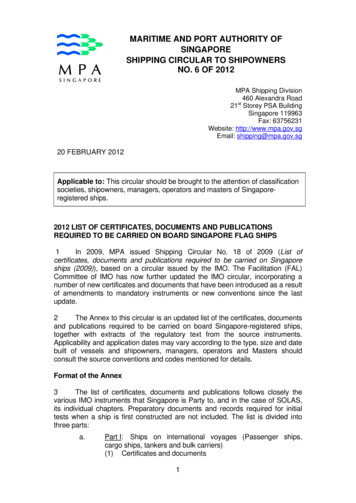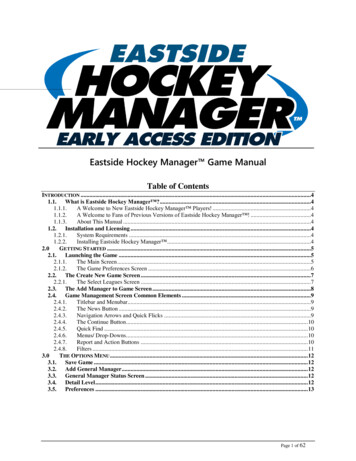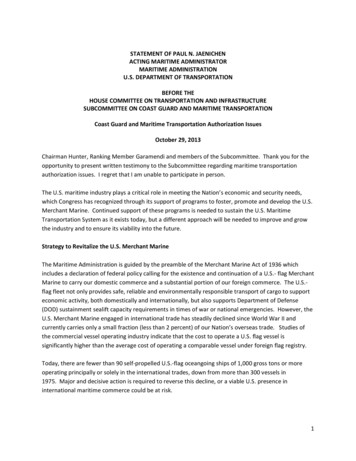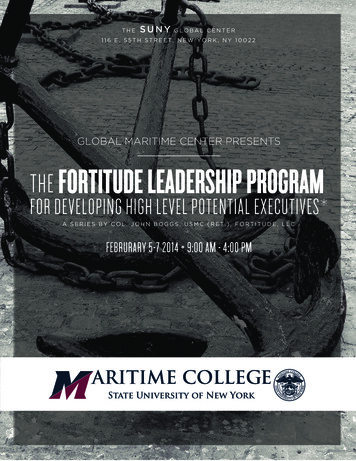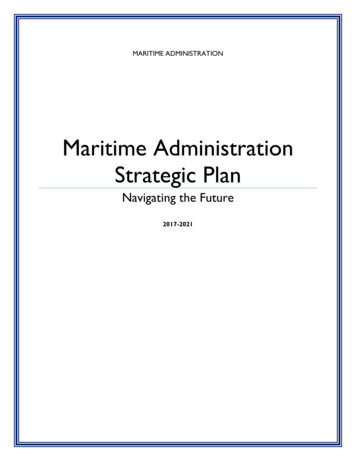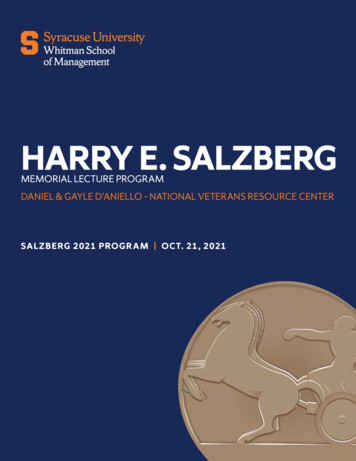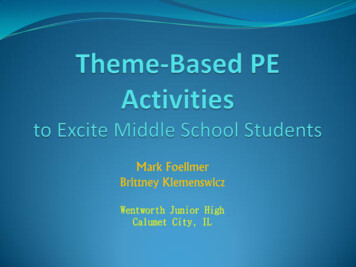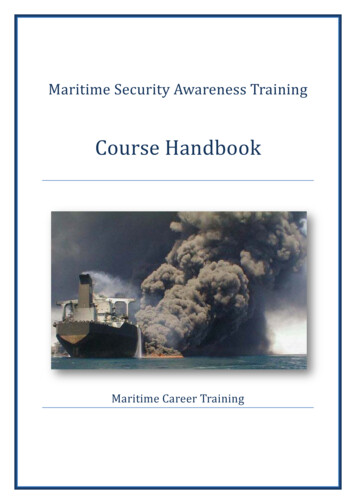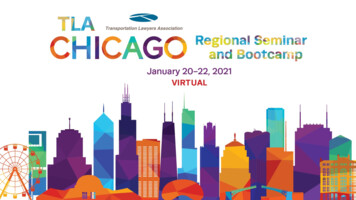
Transcription
Maritime Life! Board GameAn Interactive Career Exploration Module for High School(Grades 9-12)Additional modules can be found at:www.maritime-technology.orgThis material is based on work supported by the National Science Foundationunder Grant DUE 1501449. Any opinions, findings and conclusions orrecommendations expressed in this material are those of the author(s) and donot necessarily reflect the views of the National Science Foundation.
AuthorKelsey Warren2016 SMART Maritime and Transportation Institute AlumniLearning Outcomes-Students will gain an understanding of career options in the maritime industry.-Students will be able to develop topic relevant vocabulary as related to the maritime industry.-Students will be able to identify and compare career pathways including community and 4 yearcolleges, military, and entry level work.-Students will be able to identify the impact of continuing education opportunities on available jobsand salary.-Students will begin to explore the idea of their desired future careers.Learning ExpectationsDelivery: The content will be presented in the form of a board game. Students will take a preassessment post-assessment to gauge increase in knowledge.Time: 90 minutes. Each quiz should take 10 minutes, the board game should take 30 minutes, and theclass discussion should take 20 minutes.Grade Level: 9-12th gradeSubject Area: Career Pathways, specifically those in the maritime and transportation industries.Materials Needed: Maritime Life game board, game instructions, College Cards, Career Job Cards,College Job Cards, Continuing Education Cards, printable play money or a calculator, game pieces,scissors, writing utensil, pre-assessment, post-assessment, and classroom activity questions.Set Up: Print all game items. Print College Cards, Career Job Cards, College Job Cards, ContinuingEducation Cards, and money two sided with corresponding labels. Cut out cards and game pieces andarrange game board in correct order.Objectives-Students will be able to identify multiple career options in the maritime industry including the areasof ship maintenance and modernization, vessel operations, and port operations and marine logistics.-Students will be exposed to and be able to recite topic relevant vocabulary as related to themaritime industry.-Students will be able to identify the starting and transitional points of career pathways of communityand 4 year colleges, military, and entry level work.-Students will be able to recite 3 continuing education opportunities for the maritime andtransportation industry.
Objectives (continued)-Students will identify work related activities and expenses such as fees, healthcare, and childcarecosts.-Students will construct a list of questions they want to research for further related careerexploration.Activities1. Pre-Assessment: Students will complete the pre-assessment to determine a baseline knowledge ofcareers and educational pathways available in the maritime and transportation industry.2. Maritime Life: Students will play a board game to increase their knowledge of careers andpathways in the maritime and transportation industry.3. Post-Assessment: Students will complete a post-assessment to determine increase from baselineknowledge.4. Class Activity: Students will engage in a classroom activity to review what was learned and whatfurther action is desired to be taken in the student’s career research.Learning Standards Met (from Commonwealth of Virginia Standards of Learning)Economic and Personal Finance Standards of Learning (SOLs)EPF. 4 The student will demonstrate knowledge that many factors affect income bya) Examining the market value of a worker’s skills and knowledge.c) Explaining the relationship between a person’s own human capital and the resulting incomepotential.d) Describing how changes in supply and demand for goods and services affect income.EPF.15 The student will demonstrate knowledge of income earning and reporting bya) Examining how personal choices about education, training, skill development, and careers impactearnings.b) Differentiating among sources of income.d) Investigating employee benefits and incentives.Family Life Standards of Learning (SOLs)9.14 The student will begin to identify educational and career goals.10.8 The student will examine factors to be considered in life-goal planning.12.12 The student will prepare a plan for the fulfillment of lifelong goals.
Learning Standards Met (from Virginia SOLs) – continuedStandards for School Counseling Programs in Virginia Public SchoolsHA2. Understand the variety of post-secondary options available to them and the requirements ofthose options including the relationship of academic status and scholastic record.HA3. Demonstrate the knowledge and skills necessary to ensure a successful transition from highschool to post-secondary options.HC1. Understand the value of ethical standards and behaviors in education and the workplaceHC2. Understand how changing economic and societal needs influence employment trends andfuture trainingHC3. Understand how work and leisure interests can help to achieve personal success andsatisfaction.HC4. Understand how the changing workplace requires lifelong learning, flexibility, and theacquisition of new employment skills.HC5. Understand that behaviors such as punctuality, courtesy, proper dress and language, and hardwork are essential to success in the job market.HC10. Demonstrate knowledge of the current job market trends.Workplace Readiness Skills for CTE Courses14. Demonstrate job-acquisition and advancement skills
Pre-Assessment (5 points each)1. What are 4 occupations available for those seeking to be employed in the maritime industry?1.2.3.4.2. Describe 2 types of educational programs available to those interested in being employed in themaritime industry.1.2.3. Provide an example of the starting salary of an employee with a HS diploma or GED. per year4. Provide an example of the stating salary of an employee with college training. per year5. What is one way an employee in the maritime industry can increase their salary?1.6. What are 2 perks of working in a full-time job in the maritime and transportation industry?1.2.7. What are 2 ways to get a warning or get terminiated from a job in the maritime and transportationindustry?1.2.8. Name 3 local employers in the maritime or transportation industry.1.2.3.
Pre Assessment (continued)9. Name 2 ways to attend college for free for training in the maritime and transportation industry.1.2.10. Describe what apprentice training is. Be sure to include educational costs and work expectations.(10 points)
Post Assessment (5 points each)1. What are 4 occupations available for those seeking to be employed in the maritime industry?1.2.3.4.2. Describe 2 types of educational programs available to those interested in being employed in themaritime industry.1.2.3. Provide an example of the starting salary of an employee with a HS diploma or GED. per year4. Provide an example of the stating salary of an employee with college training. per year5. What is one way an employee in the maritime industry can increase their salary?1.6. What are 2 perks of working in a full-time job in the maritime and transportation industry?1.2.7. What are 2 ways to get a warning or get terminiated from a job in the maritime and transportationindustry?1.2.8. Name 3 local employers in the maritime or transportation industry.1.2.3.
Post Assessment continued9. Name 2 ways to attend college for free for training in the maritime and transportation industry.1.2.10. Describe what apprentice training is. Be sure to include educational costs and work expectations.(10 points)
Teacher Answer KeyAll answers listed in the key are found during game play. Other answers may be accepted at theteacher’s discretion.1. What are 4 occupations available for those seeking to be employed in the maritime industry?Electrician, Marine Diesel Mechanic, Enlisted Sailor, Food Service and Hospitality Sailor, Crane andTower Operator, Pipe Fitter, Shipping, Receiving, and Traffic Clerk, Ordinary Seaman, Able Seaman,Unlicensed Junior Engineer, Qualified Member of the Engine Department (QMED), Welder, IndustrialEngineer, HVAC Mechanic and Installer, Human Factors Engineer and Ergonomist, Second Mate, NavyOfficer, Chief Engineer, Stage and Distribution Manager, and Enlisted Transportation Officer.2. Describe 2 types of colleges or educational programs available to those interested in beingemployed in the maritime industry.Tidewater Community College, SUNY Maritime College, US Merchant Marine Academy, and MidAtlantic Maritime Academy3. Provide an example of the starting salary of an employee with a HS diploma or GED.Between 22,000 and 45,000 per year4. Provide an example of the stating salary of an employee with college training.Between 42,000 and 80,000 per year5. What is one way an employee in the maritime industry can increase their salary?Obtain an industry credential such as DOL Journeyman, continuing education such as a certificate ordegree, and job promotions to supervisor or manager6. What are 2 perks of working in a full-time job in the maritime and transportation industry?Health insurance, paid days off, using skills to save money on household tasks, using skills to earnextra money on side jobs, and promotion opportunities7. What are 2 ways to get a warning or get terminated from a job in the maritime andtransportation industry?Being late, missing work, and fail drug screening8. Name 3 local employers in the maritime or transportation industry.BAE Shipyard, Ocean Marine Yacht Center, The Port of Virginia, OCEANEERING, AMSEC, ElizabethRiver Ferry, Carnival Cruise Line, U.S. Navy, Colona’s Shipyard, and Norfolk Naval Shipyard.
Teacher Answer Key (continued)9. Name 2 ways to attend college for free for training in the maritime and transportation industry.College scholarship, attend a US Merchant Marine Academy and owe service to the armed forces, beselected for an apprenticeship10. Describe what apprentice training is. Be sure to include educational costs and workexpectations. (10 points)You work for pay during the day and attend college at night at no cost to obtain a Trades TechnicianStudies Certificate
Classroom Discussion QuestionsWas anything you learned today new or surprising to you?Has your opinion of those employed in the shipyard changed? If so, how?What are some new terms you learned today? Are there terms you need clarification on, such asTWIC Card?Does anyone know someone employed in this industry? Tell us about their work.What are some new career options you learned about today?Do any of these careers interest you as a possible job?What type of educational path would you need to take to get employed in that job? If you aren’tsure, where can you go for assistance?If you worked in this industry, do you think you’d prefer to stay in a job or go back for continuingeducation? What would be the advantages and disadvantages to your choice?Take a few moments to write down a list of questions you want to research further about thisindustry or your own career exploration.
ReferencesGeneral tion com wrapper&view wrapper&Itemid t/odu/academics/programs.html#program type ww.amsec.com/AMSEC colonnaship.com/employment.html
careers and educational pathways available in the maritime and transportation industry. 2. Maritime Life: Students will play a board game to increase their knowledge of careers and pathways in the maritime and transportation industry. 3. Post-Assessment: Students will complete a post-assessment to determine increase from baseline knowledge. 4.
